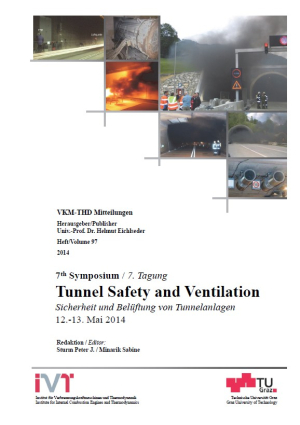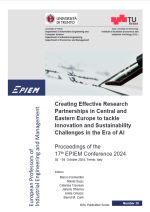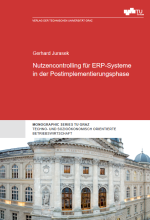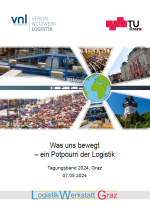PREFACE
Ladies and Gentlemen, Dear Participants,
In 2002, the Institute of Internal Combustion Engines and Thermodynamics organized an International Conference on Tunnel Safety and Ventilation. The aim of that conference was to provide a forum for information exchange among operators, users, technicians, scientists and companies involved in the design, construction and equipping of road and rail tunnels. The success of the 2002 conference led to the organization of biennial follow up meetings.
Each conference has been accompanied by an exhibition, and each year, like the conference itself, the exhibition has grown. The success of the exhibitions has forced us to leave the confines of our University campus and to move to the roomier facilities of the trade fair centre.
Our interests and focus have also changed and this is reflected in our topics. The first conferences were strongly influenced by the tunnel incidents of the late 1990’s and related safety issues. Nowadays road tunnel operation, the conflict between the needs for upgrading existing road tunnels and requirements given in a legal framework dominate.
Traffic is increasing, at both a national as well as an international level. Thus, while in densely populated areas there is much greater demand for sub-surface transportation, in rural areas there is an increasing need to upgrade the road infrastructure. The implementation of the
EU Directive on the minimum safety requirements for tunnels in the trans-European road network (2004/54/EC) forced many of the tunnel operators to upgrade the existing tunnels.
Many of the existing tunnels (i.e. those 20 to 30 years old), are currently being refurbished and upgraded by the addition of a second tunnel tube. The upgrading process as well as the construction of second tubes constitutes a big challenge in practice, as – in contrast to new tunnel construction – several prevailing structures and systems act as constraints and have to be taken into consideration in planning. There is also the additional need to ensure that traffic flow can be maintained throughout the construction period.
The question of tunnel safety is a highly controversial field. It is often claimed that several new techniques are now on the market and that these can help improve safety due to quicker and more reliable detection, more efficient installations and/or additional equipment.
However, such ‘improvements’ often result in significant increases in complexity, as well as in the cost of operation and maintenance of the new safety equipment.
Cost benefit analyses combined with risk assessment studies provide a valuable tool when attempting to deal with questions of safety at an acceptable cost level. The time is now right for us to discuss what safety standards are required in our tunnels and at what price. We hope that the present conference will be of some value in such a discussion.
This conference wouldn’t be the “Graz” conference without the related exhibition. Many companies have put a lot of effort into presenting their latest developments and technologies. Conference participants now have the chance to get into contact with leading companies in the electro-mechanical tunnel business, to establish new contacts, and also to strengthen existing ones.
7thInternational Conference ‘Tunnel Safety and Ventilation’ 2014, Graz
Another exciting and distinguishing aspect of the “Graz” conference is its live fire test. This final highlight of the conference will be performed in the Plabutsch Tunnel close to the city of
Graz. In fact the conference returns to the location where its first fire test took place in 2004.
Many thanks to the tunnel operator ASFiNAG as well as to the rescue forces (fire brigade of the City of Graz, Red Cross and other relevant organizations). Special thanks to Mrs. Dagmar
Jäger, Mr. Alois Knoll, Mr. Josef Heschl from ASFiNAG and to Mr. Gerald Wonner from the fire brigade of the City of Graz as well as to Michael Bacher and Thomas Nöst from our Institute for organizing this test.
We wish to extend a special thank you to our scientific committee for its valuable work in defining the objectives of this conference, and in selecting the presentations.
We also extend our professional thanks to the authors for their hard work in preparing abstracts, papers, posters, and of course their presentations.
And finally, we wish to offer our sincere thanks to all the people in the background who have been working to ensure that this will be a smooth, enjoyable and effective conference for us all.
It is my pleasure to welcome you all on behalf of the conference scientific committee and to wish you all a successful meeting and a sound basis for fertile networking in the future.
Peter J. Sturm
Ausgabe: kartoniert
ISBN: 978-3-85125-320-7
Umfang: 280 Seiten
Sprache: Deutsch, Englisch
Erschienen: Juli 2014
Reihe: iTnA-Reports ab Vol. 105; IVT-Mitteilungen ab Vol. 100; VKM-THD Mitteilungen, Band 97
Vergriffen!
PREFACE
Ladies and Gentlemen, Dear Participants,
In 2002, the Institute of Internal Combustion Engines and Thermodynamics organized an International Conference on Tunnel Safety and Ventilation. The aim of that conference was to provide a forum for information exchange among operators, users, technicians, scientists and companies involved in the design, construction and equipping of road and rail tunnels. The success of the 2002 conference led to the organization of biennial follow up meetings.
Each conference has been accompanied by an exhibition, and each year, like the conference itself, the exhibition has grown. The success of the exhibitions has forced us to leave the confines of our University campus and to move to the roomier facilities of the trade fair centre.
Our interests and focus have also changed and this is reflected in our topics. The first conferences were strongly influenced by the tunnel incidents of the late 1990’s and related safety issues. Nowadays road tunnel operation, the conflict between the needs for upgrading existing road tunnels and requirements given in a legal framework dominate.
Traffic is increasing, at both a national as well as an international level. Thus, while in densely populated areas there is much greater demand for sub-surface transportation, in rural areas there is an increasing need to upgrade the road infrastructure. The implementation of the
EU Directive on the minimum safety requirements for tunnels in the trans-European road network (2004/54/EC) forced many of the tunnel operators to upgrade the existing tunnels.
Many of the existing tunnels (i.e. those 20 to 30 years old), are currently being refurbished and upgraded by the addition of a second tunnel tube. The upgrading process as well as the construction of second tubes constitutes a big challenge in practice, as – in contrast to new tunnel construction – several prevailing structures and systems act as constraints and have to be taken into consideration in planning. There is also the additional need to ensure that traffic flow can be maintained throughout the construction period.
The question of tunnel safety is a highly controversial field. It is often claimed that several new techniques are now on the market and that these can help improve safety due to quicker and more reliable detection, more efficient installations and/or additional equipment.
However, such ‘improvements’ often result in significant increases in complexity, as well as in the cost of operation and maintenance of the new safety equipment.
Cost benefit analyses combined with risk assessment studies provide a valuable tool when attempting to deal with questions of safety at an acceptable cost level. The time is now right for us to discuss what safety standards are required in our tunnels and at what price. We hope that the present conference will be of some value in such a discussion.
This conference wouldn’t be the “Graz” conference without the related exhibition. Many companies have put a lot of effort into presenting their latest developments and technologies. Conference participants now have the chance to get into contact with leading companies in the electro-mechanical tunnel business, to establish new contacts, and also to strengthen existing ones.
7thInternational Conference ‘Tunnel Safety and Ventilation’ 2014, Graz
Another exciting and distinguishing aspect of the “Graz” conference is its live fire test. This final highlight of the conference will be performed in the Plabutsch Tunnel close to the city of
Graz. In fact the conference returns to the location where its first fire test took place in 2004.
Many thanks to the tunnel operator ASFiNAG as well as to the rescue forces (fire brigade of the City of Graz, Red Cross and other relevant organizations). Special thanks to Mrs. Dagmar
Jäger, Mr. Alois Knoll, Mr. Josef Heschl from ASFiNAG and to Mr. Gerald Wonner from the fire brigade of the City of Graz as well as to Michael Bacher and Thomas Nöst from our Institute for organizing this test.
We wish to extend a special thank you to our scientific committee for its valuable work in defining the objectives of this conference, and in selecting the presentations.
We also extend our professional thanks to the authors for their hard work in preparing abstracts, papers, posters, and of course their presentations.
And finally, we wish to offer our sincere thanks to all the people in the background who have been working to ensure that this will be a smooth, enjoyable and effective conference for us all.
It is my pleasure to welcome you all on behalf of the conference scientific committee and to wish you all a successful meeting and a sound basis for fertile networking in the future.
Peter J. Sturm
Das könnte Sie auch interessieren
- Gesamtverzeichnis
- Neuerscheinungen
-
Open-Access-Publikationen

- Multimediale E-Books
-
Reihen
- Akademische Reden an der Technischen Universität Graz
- Arbeitshilfen für die Praxis
- Archiv und Bibliothek
- Betonkolloquium
- Buddhist Architecture in the Western Himalayas
- BWL Schriftenreihe
- Electrical Power Systems
- Fachbücher Planung und Bau
- Facts & Figures
- Festschriften TU Graz
- Forschungsreihe IBBW
- Forum Technik und Gesellschaft
- Geodesy
- Immersive Learning Research Network Conference; Workshop, short papers, poster
- Institut für Gebäudelehre Jahrbuch
- International Brain-Computer Interface (BCI) Meeting
- LM.VM.2014
- Logistik Werkstatt Graz
- Materialien zu Schwerpunkten am Institut für Gebäudelehre
- Mathematical Modelling of Weld Phenomena
- Monographic Series TU Graz
- Monographic Series TU Graz|Advanced Materials Science
- Monographic Series TU Graz|Computation in Engineering and Science
- Monographic Series TU Graz|Production Science and Management
- Monographic Series TU Graz|Railway Research
- Monographic Series TU Graz|Reihe Fahrzeugtechnik
- Monographic Series TU Graz|Schriftenreihe des Instituts Betonbau
- Monographic Series TU Graz|Structural Analysis
- Monographic Series TU Graz|Techno- und sozioökonomisch orientierte Betriebswirtschaft
- Monographic Series TU Graz|Technoökonomie und industrielles Management
- Monographic Series TU Graz|Timber Engineering & Technology
- November Talks
- Proceedings of the International Brain-Computer Interface
- Schriftenreihe des Instituts für Baubetrieb und Bauwirtschaft
- Schriftenreihe des Instituts für Straßen- und Verkehrswesen
- Schriftenreihe des Instituts für Wohnbau der TU Graz
- Schriftenreihe zur Wasserwirtschaft
- Science, Technology and Society online
- Seminarreihe Bauunternehmensführung
- Studien zur Architektur | TU Graz
- Textbook Series
- Transform Industry: Guiding the transformation of SMEs
- TU Graz Jahresbericht | Annual report
- TU Graz people
- TU Graz Research
- VKM-THD Mitteilungen; IVT-Mitteilungen ab Bd. 100
- Publizierende von A-Z
- Angebote
Kontakt
Verlag der
Technischen Universität Graz
Technikerstraße 4
8010 Graz, Österreich
UID(VAT) ATU 57477929
Kontaktperson
Gabriele Groß
Tel.: +43(0)316 873 6157
E-Mail: verlag [ at ] tugraz.at
Datenschutzübersicht
Notwendige Cookies sind für die ordnungsgemäße Funktion der Website unbedingt erforderlich. Diese Cookies stellen anonym grundlegende Funktionen und Sicherheitsfunktionen der Website sicher.
| Cookie | Dauer | Beschreibung |
|---|---|---|
| cookielawinfo-checkbox-analytics | 11 Monate | Dieses Cookie wird vom GDPR Cookie Consent Plugin gesetzt. Das Cookie wird verwendet, um die Zustimmung des Benutzers für die Cookies in der Kategorie „Analytics“ zu speichern. |
| cookielawinfo-checkbox-functional | 11 Monate | Das Cookie wird durch die DSGVO-Cookie-Zustimmung gesetzt, um die Zustimmung des Benutzers für die Cookies in der Kategorie "Funktional" zu erfassen. |
| cookielawinfo-checkbox-necessary | 11 Monate | Dieses Cookie wird vom GDPR Cookie Consent Plugin gesetzt. Die Cookies werden verwendet, um die Zustimmung des Benutzers für die Cookies in der Kategorie „Notwendig“ zu speichern. |
| qtrans_front_language | 1 Jahr | Dieses Cookie wird vom qTranslate WordPress-Plugin gesetzt. Das Cookie wird verwendet, um die bevorzugte Sprache des Besuchers zu verwalten. |
| viewed_cookie_policy | 11 Monate | Das Cookie wird vom Plugin GDPR Cookie Consent gesetzt und wird verwendet, um zu speichern, ob der Benutzer der Verwendung von Cookies zugestimmt hat oder nicht. Es werden keine personenbezogenen Daten gespeichert. |
| woocommerce_cart_hash | session | Dieses Cookie wird von WooCommerce gesetzt. Das Cookie hilft WooCommerce dabei, festzustellen, wann sich der Inhalt/die Daten des Warenkorbs ändert. |
Analyse-Cookies werden verwendet, um zu verstehen, wie Besucher mit der Website interagieren. Diese Cookies helfen dabei, Informationen zu Metriken wie Anzahl der Besucher, Absprungrate, Verkehrsquelle usw. bereitzustellen.
| Cookie | Dauer | Beschreibung |
|---|---|---|
| _pk_id | 1 Jahr 27 Tage | Erforderlich für den Betrieb von Matomo, einem Analysetool, das das Nutzerverhalten verfolgt und analysiert. |
| _pk_ref | 13 Monate | Erforderlich für den Betrieb von Matomo, einem Analysetool, das das Nutzerverhalten verfolgt und analysiert. |
| _pk_ses | 30 Minuten | Erforderlich für den Betrieb von Matomo, einem Analysetool, das das Nutzerverhalten verfolgt und analysiert. |
Andere nicht kategorisierte Cookies sind diejenigen, die analysiert werden und noch nicht in eine Kategorie eingeordnet wurden.
| Cookie | Dauer | Beschreibung |
|---|---|---|
| yt-remote-connected-devices | niemals | Speichert die Benutzereinstellungen beim Abruf eines auf anderen Webseiten integrierten Youtube-Videos |
| yt-remote-device-id | niemals | Speichert die Benutzereinstellungen beim Abruf eines auf anderen Webseiten integrierten Youtube-Videos |






